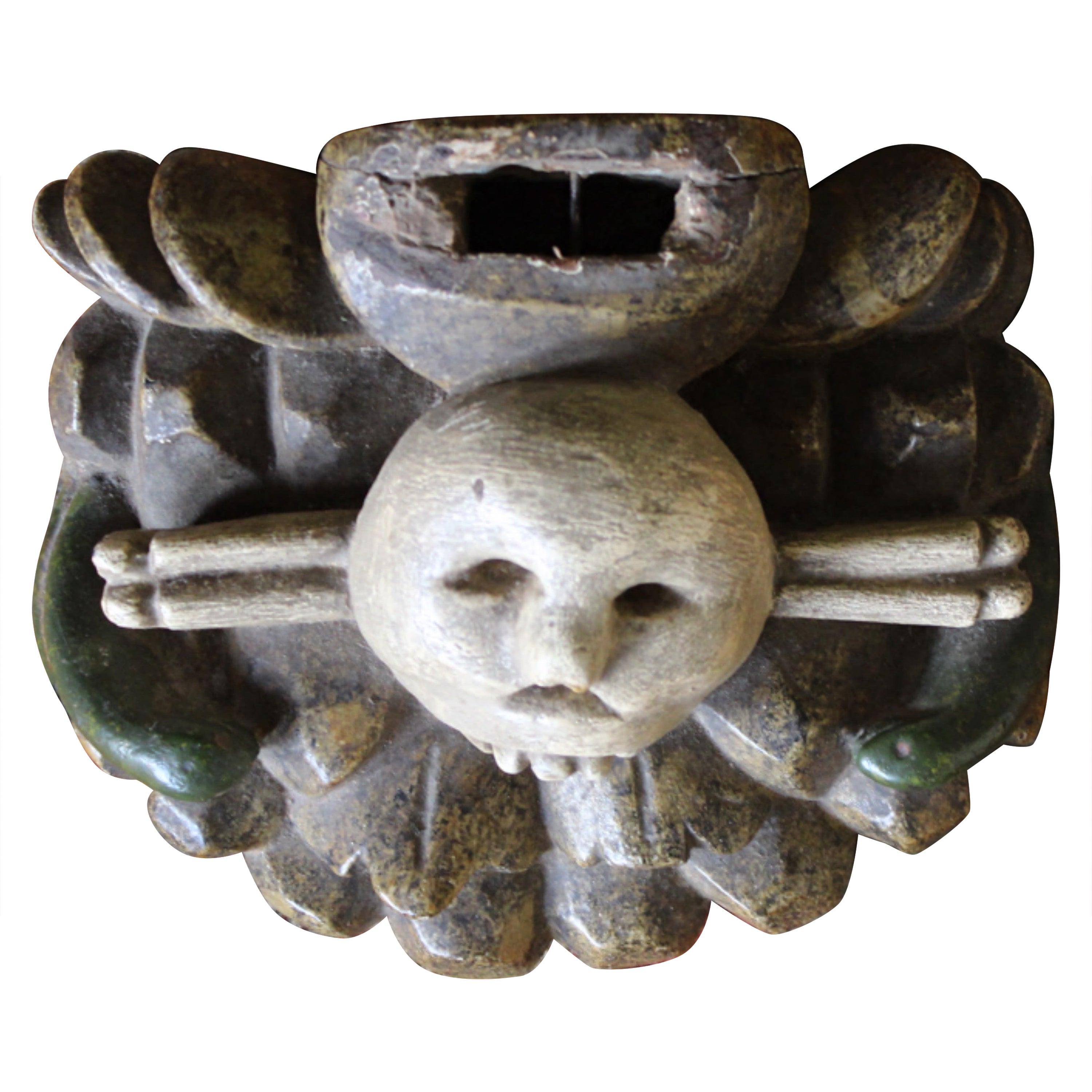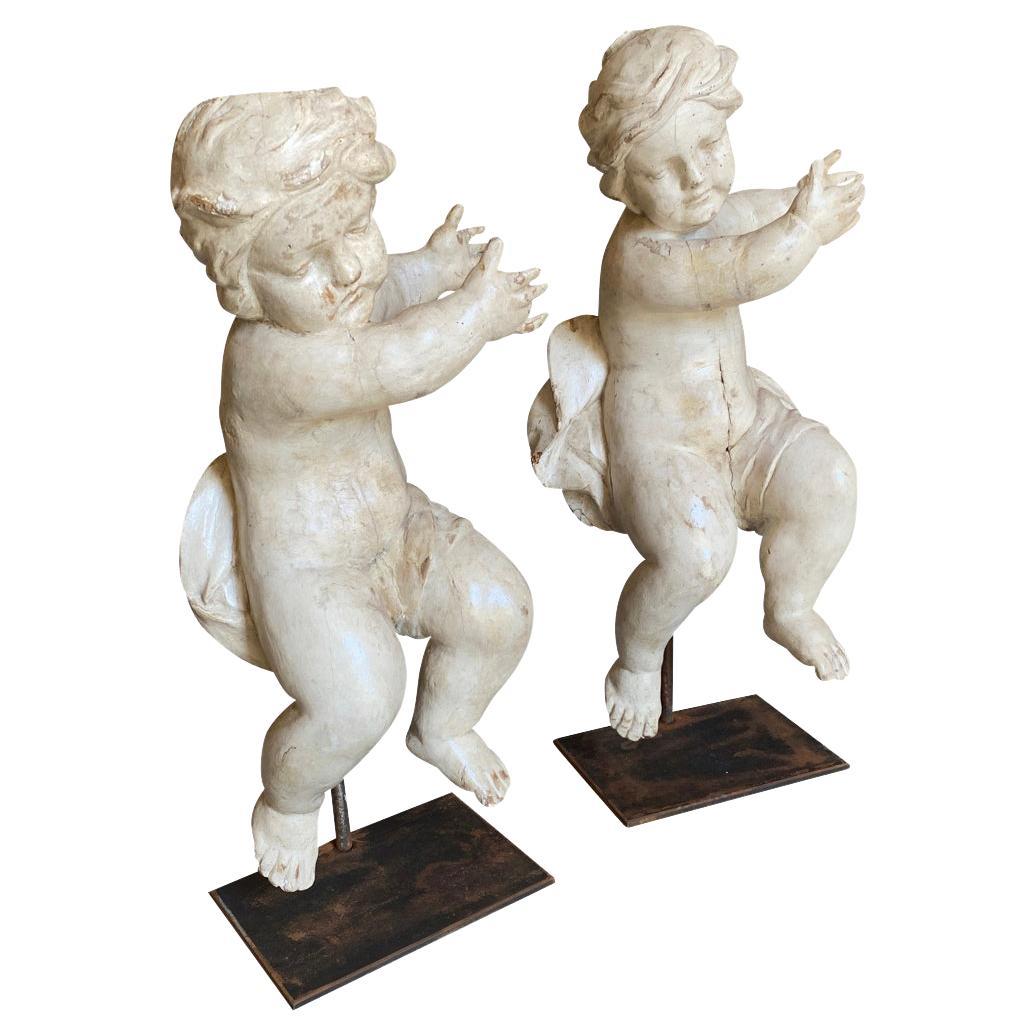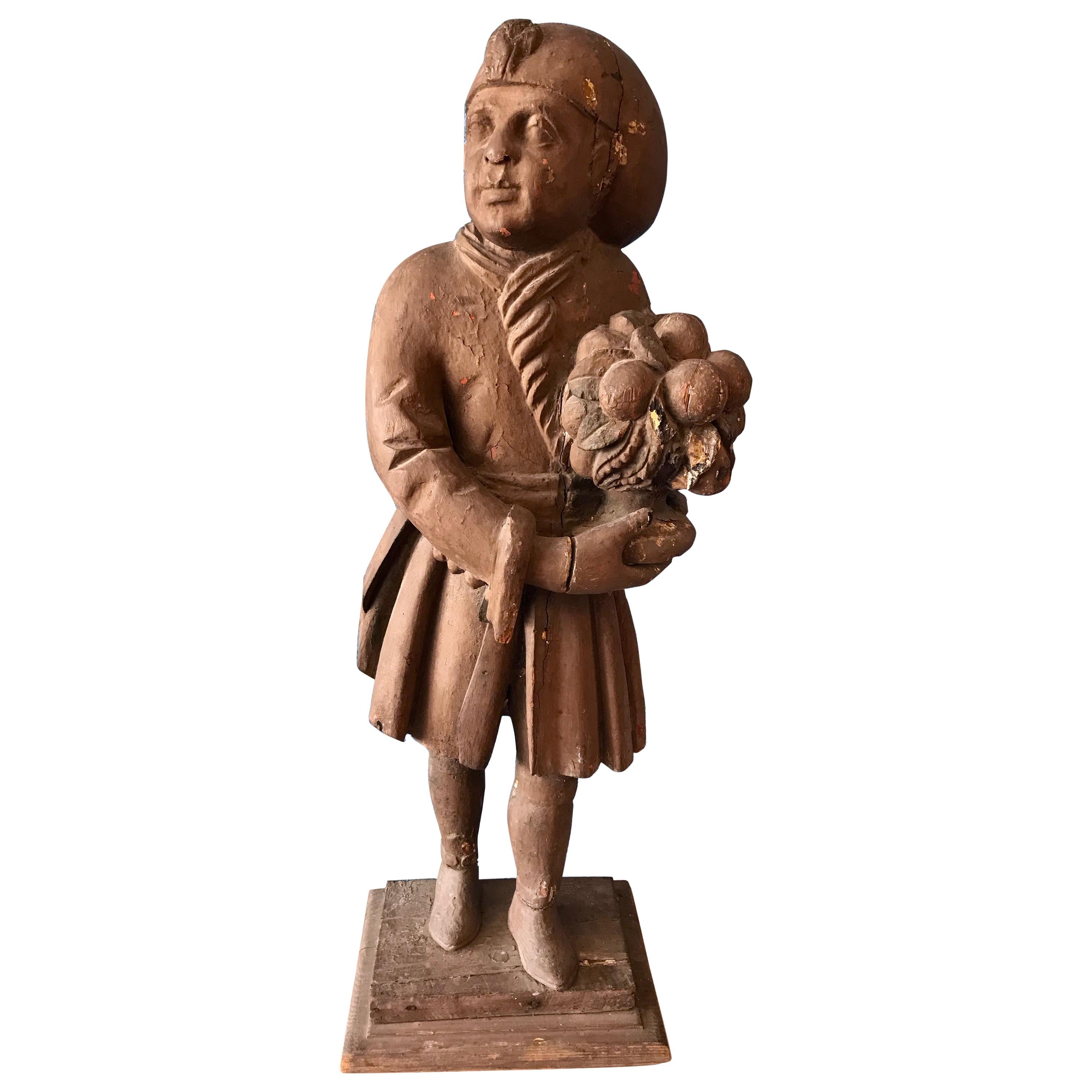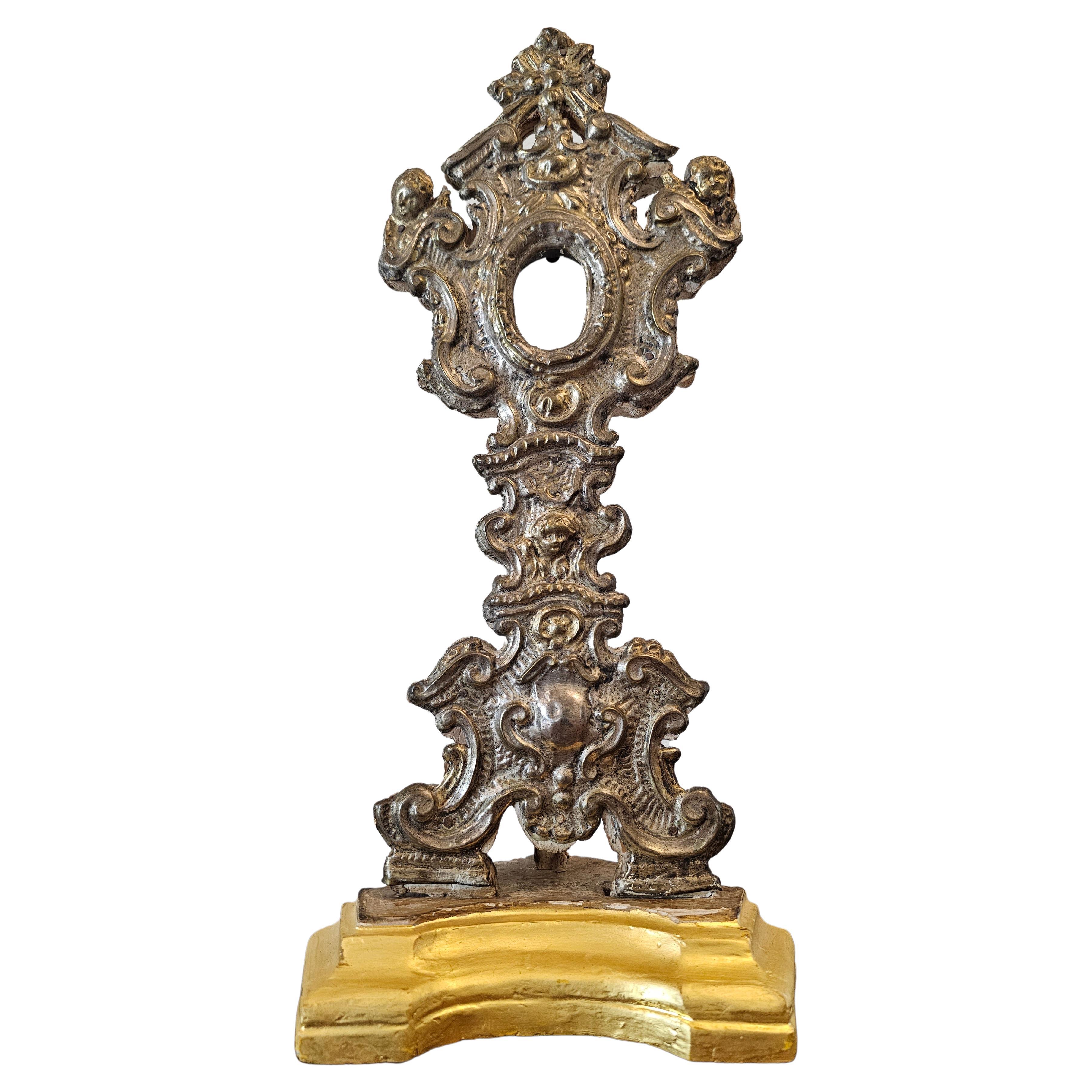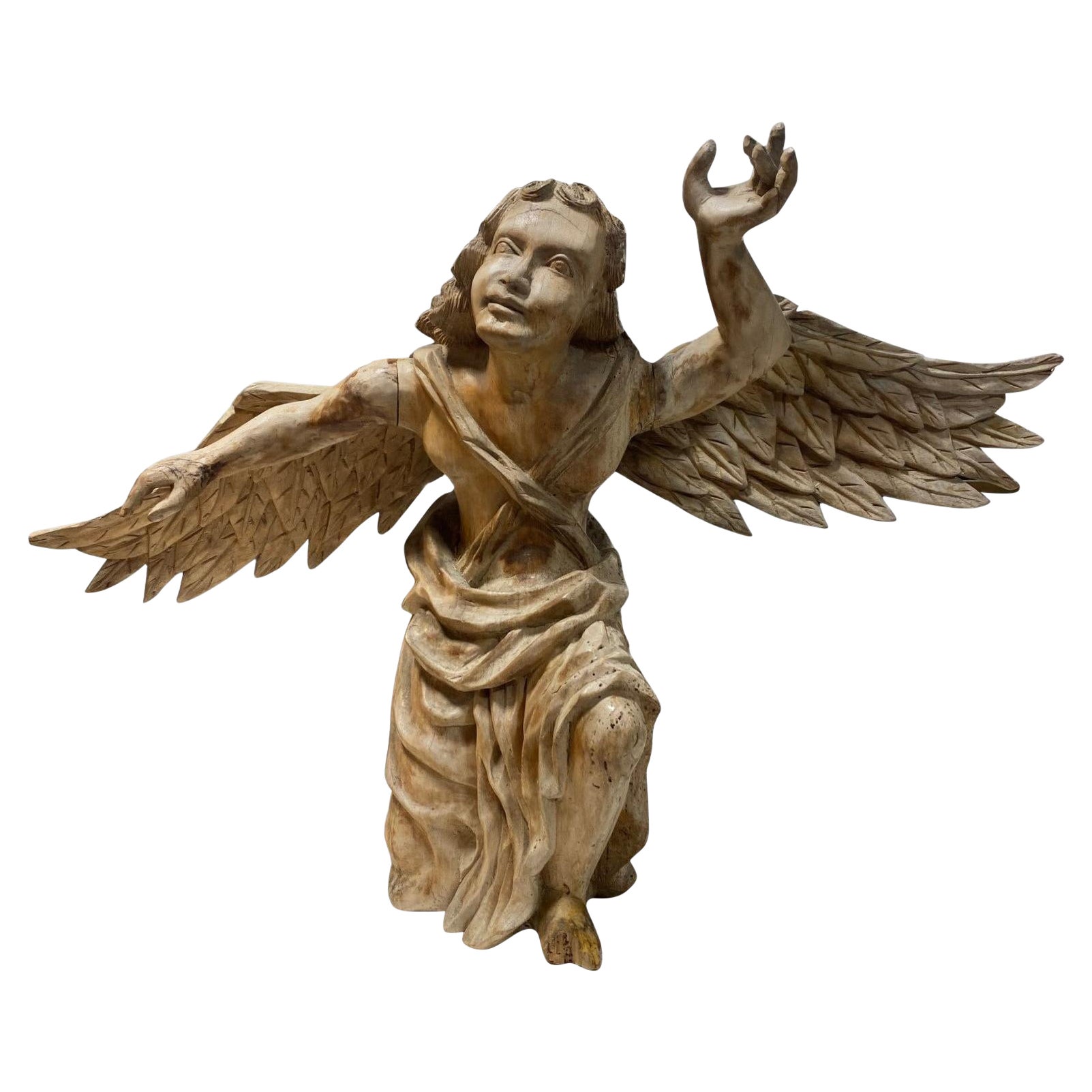Items Similar to 18th Century German Baroque Architectural Putti Bust Wall Shelf Carving
Want more images or videos?
Request additional images or videos from the seller
1 of 21
18th Century German Baroque Architectural Putti Bust Wall Shelf Carving
About the Item
A finely carved Baroque period architectural element, now fashioned as a sculptural bracket shelf.
Hand-crafted by a master-artisan in the 18th century, originally part of a corbel, likely from a church around the Black Forest region of Southern Germany. Exquisitely hand carved solid walnut, exceptionally executed and intricately detailed, featuring two protruding busts of cherub children with fine facial details and sculpted wavy hair, over pierced foliate floral decoration. circa 1750
Provenance / Acquisition:
Property from the magnificent estate of the late T. Boone Pickens (1928 -2019). An American business magnate and financier.
Acquired from the highly reputable auction house J. Garrett Auctioneers, Dallas, Texas. September 2022 More of T. Boone Pickens Estate catalog
J. Garrett Auctioneers had the pleasure of presenting this item from the iconic Texas and Oklahoma oil tycoon, T. Boone Pickens' estate.
The breadth of T. Boone Pickens' career is impressive. He built one of the largest independent natural gas oil companies in the United States and flourished as an entrepreneur thereafter, generating hundreds of billions of dollars in the process. Among his lengthy accolades, Time magazine has identified him one of its "100 Most Influential People", Financial World named him "CEO of the Decade" in 1989, and Oil and Gas Investor identified him as one of the "100 Most Influential People of the Petroleum Century."
Dimensions: (approx)
8" High, 7" Wide, 8.75" Deep
Condition Report:
Great antique condition, especially considering its age. Nicely aged warm rich dark rustic patina, later shellacked surface, wear consistent with age and use, including age related shrinkage fissure. Later metal wall hanging mount to verso.
A wonderful example of Baroque period European folk art, the antique architectural salvage building ornament repurposed as a decorative wall sculpture - candle shelf, is sure to add sophisticated elegance, whimsical rustic warmth, and classic style, as well as rich cultural and historical interest to any space!
- Dimensions:Height: 8 in (20.32 cm)Width: 7 in (17.78 cm)Depth: 8.75 in (22.23 cm)
- Style:Baroque (Of the Period)
- Materials and Techniques:
- Place of Origin:
- Period:
- Date of Manufacture:circa 1750
- Condition:Wear consistent with age and use. Great antique condition, especially considering its age. Nicely aged warm rich dark rustic patina, later shellacked surface, wear consistent with age and use, including age related shrinkage fissure. Later metal wall hanging mount to verso.
- Seller Location:Forney, TX
- Reference Number:1stDibs: LU5977238710122
About the Seller
4.8
Platinum Seller
These expertly vetted sellers are 1stDibs' most experienced sellers and are rated highest by our customers.
Established in 2013
1stDibs seller since 2021
200 sales on 1stDibs
Typical response time: <1 hour
- ShippingRetrieving quote...Ships From: Forney, TX
- Return PolicyA return for this item may be initiated within 7 days of delivery.
More From This SellerView All
- 18th/19th Century Italian Baroque Silvered Metal Altar Monstrance ReliquaryLocated in Forney, TXA stunning antique Italian Baroque style silvered metal gilded wood monstrance reliquary. circa 1770-1820 Handmade in Italy in the late 18th / early 19th century, commissioned by the church to display an important religious relic, sculptural painted wood form, mounted with decorative silver repousse metal facing, open oval window where the philatory relic was once housed, rising on a gold gilt painted shaped plinth base. Dimensions: (approx) 17" High, 8" Wide, 5" Deep, 1.25lbs History: Reliquaries (also referred to as a shrine or châsse in French), are containers used to protect and display relics. A portable reliquary may be called a fereter, and a chapel in which it is housed a feretory. A monstrance, also known as an ostensorium (or an ostensory), is a vessel used in Roman Catholic, Old Catholic, High Church Lutheran and Anglican churches for the display on an altar of some object of piety, such as the consecrated Eucharistic host during Eucharistic adoration or Benediction of the Blessed Sacrament. It is also used as reliquary for the public display of relics of some saints. The use of reliquaries became an important part of Christian practices from at least the 4th century, initially in the Eastern Churches, which adopted the practice of moving and dividing the bodies of saints much earlier than the West, probably in part because the new capital of Constantinople, unlike Rome, lacked buried saints. Relics are venerated in the Oriental Orthodox, Eastern Orthodox, Roman Catholic and some Anglican Churches. Reliquaries provide a means of protecting and displaying relics. While frequently taking the form of caskets, they range in size from simple pendants or rings to very elaborate ossuaries. The relics were enshrined in containers crafted of or covered with gold, silver, gems, and enamel. These objects constituted a important form of artistic production across Europe and Byzantium throughout the Middle Ages. Many were designed with portability in mind, often being exhibited in public or carried in procession on the saint's feast day or on other holy days. Pilgrimages often centered on the veneration of relics. The faithful often venerate relics by bowing before the reliquary or kissing it; those churches which observe the veneration of relics distinguish between the honor given to the saints and the worship that is due to God alone. Sixteenth-century reformers such as Martin Luther opposed the use of relics since many had no proof of historical authenticity and objected to a cult of saints. Many reliquaries, particularly in northern Europe, were destroyed by Calvinists or Calvinist sympathizers during the Reformation...Category
Antique Early 19th Century Italian Baroque Sculptures and Carvings
MaterialsMetal
- 18th Century Swedish Carved Mangle BoardLocated in Forney, TXA long hand carved wooden mangle board (clothing and bedding press) with beautiful patina. Handmade in Sweden, circa 1744, this Scandinavian antique with...Category
Antique 18th Century Swedish Primitive Sculptures and Carvings
MaterialsWood
- 18th Century German Baroque Sauteuse CommodeLocated in Forney, TXA unique signed original Baroque Sauteuse commode from the 18th century. Exceptionally executed, this elegant German mid-sized walnut cabinet presents with absolutely beautiful inlay works, including patchwork marquetry, scrolled inlay and fine inlayed thread work that provide this unique period commode a fine touch of luxury. Finished in Rococo Louis XV taste, the artisans carefully selected highest quality, warm, rich woods, including burled walnut, fruitwood, olive wood, burl maple and various other exotic woods. Having a serpentine shaped top and case fitted with two gorgeous curved drawers, each with parcel-gilt brass pulls and interior paper lining marked Fabrication Allemande. Both the case and drawers have been joined by hand carved dovetail joinery. Resting over a wonderfully shaped and hand carved solid walnut base, accented by simple scroll running ornamentation carvings along the apron, gracefully rising on high cabriole legs, terminating on hoof feet. Signed/Stamped, interior, legible. It is one of the pieces of our extensive collection richer in inlays, very warm and complex, a feature that made us literally fall in love at first sight of this beautiful antique dresser...Category
Antique 18th Century Baroque Commodes and Chests of Drawers
MaterialsFruitwood, Maple, Olive, Walnut, Burl
- 18th/19th Century Spanish Colonial Carved Polychrome Wood Santo Altar SculptureLocated in Forney, TXA most impressive antique Spanish Colonial hand carved polychromed wood Santo Catholic church altar figure. circa 1800 Hand-crafted in the late 18th / early 19th century, exceptionally executed intricate detailing, the large scale antique religious sculpture depicting the female Saint Teresa of Avila, polychrome painted gesso over finely sculpted wood, inset glass eyes, shown in Carmelite nun habit...Category
Antique Late 18th Century Spanish Colonial Sculptures and Carvings
MaterialsGesso, Wood, Paint
- Early 19th Century French Carved Giltwood Figural Winged Putti Table LampLocated in Forney, TXA fabulous French Empire period giltwood figural candlestick, early 19th century, now professionally electrified and fashioned as a single-light table lamp. Exquisitely hand carve...Category
Antique Early 19th Century French Rococo Table Lamps
MaterialsGesso, Giltwood
- 19th Century Hindu Nandi Temple Guardian, Architectural OrnamentLocated in Forney, TXA monumental Hindu Nandi temple gate-guardian architectural ornament, born in India, dating to the 19th century, hand carved and painted, richly detailed, polychrome decorated, the w...Category
Antique 19th Century Indian Folk Art Sculptures and Carvings
MaterialsGesso, Wood, Paint
You May Also Like
- 18th Century Memento Mori Carving Shelf Calvarium Ledge Macabre Curio AntiqueLocated in Lowestoft, GBA finely carved Memento Mori base to hold the holy cross, now hangs to make for a decorative wee shelf. Original polychromed painted decoration, European in origins, age related wear...Category
Antique 18th Century European Sculptures and Carvings
MaterialsHardwood
- Pair of 18th Century Italian PuttiLocated in Atlanta, GAA stunning pair of mid-18th century Italian Baroque Putti beautifully crafted in polychromed wood - now resting on their iron stands. Charming position w...Category
Antique 18th Century Italian Figurative Sculptures
MaterialsWood
- Late 18th / Early 19th Century Carvings of a PharaohLocated in West Palm Beach, FLAn unusual subject in an interesting pose with a bundle of fruits in his arms. The clothes, head piece, etc., are well detailed.Category
Antique 19th Century European Figurative Sculptures
MaterialsWood
- 18th Century Continental Italian Baroque Wood Carved Kneeling Angel SculptureLocated in Studio City, CAA truly magnificent and wonderful large hand-carved Italian Baroque wood church angel from the 18th Century. This work, which at one point was likely pol...Category
Antique 18th Century Italian Baroque Sculptures and Carvings
MaterialsWood
- 18th C Rare Wood Female Carving ArtifactLocated in Malibu, CA18th century wooden carving of an female form. Presumed to be a French church piece. This figure has a beautiful face.Category
Antique 18th Century French Renaissance Sculptures and Carvings
MaterialsWood
- Late 17th/Early 18th Century Polychrome Tobacconist Figure Sign Folk Art CarvingLocated in Lowestoft, GBA large carved and polychrome painted tobacconist's figure almost certainly 17th or early 18th century For a related example see Edward H. Pinto, Treen and other Wooden Bygones, Bell and Hyman, London 1969. Page 412, plate 436. Originally this may well have been a tobacconist's shop window figure. For a similar, but slightly earlier unpainted example, see Sotheby's, The W. J. Shepherd collection of treen, 30th November 1983, Lot 393, illustrated in Pinto "Wooden Bygones of Smoking and Snuff Taking", plate 1. Carved wooden figures, often painted, were placed outside tobacconist's shops as signs from the 17th century onwards. The earliest of these figures is the 'black boy' or 'blackamoor'. 'At the sign of the black boy' or 'at the sign of the blackamoor' was a popular address for tobacconists since the early 17th century. The 17th century figures...Category
Antique 17th Century English Sculptures and Carvings
MaterialsPine
